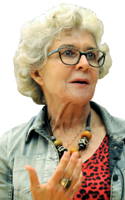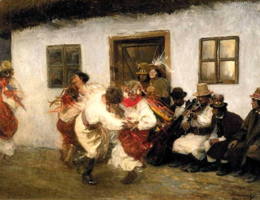
|
The Society of Folk Dance Historians (SFDH)
Ukrainian Dance and Music
[
Home |
About |
Encyclopedia | CLICK AN IMAGE TO ENLARGE |

|
DANCES
 In contrast with Ukrainian folksongs, rich in melodies and varied in rhythmical structures, the folk dances of the Ukraine are mostly in duple time and based on symmetrical musical periods. The principal dances are closely related musically and only different accents establish their choreographic characteristics. Dances were usually incorporated into rituals such as weddings and holidays. The Ukrainians have many dances that imitate daily life and work, such as Kozak, Kysil, Buhaj, Poltavka, Dudochka, Metelytsia, Hajduk, Chaban, and many others. The most prominent Ukrainian folk dances are:
In contrast with Ukrainian folksongs, rich in melodies and varied in rhythmical structures, the folk dances of the Ukraine are mostly in duple time and based on symmetrical musical periods. The principal dances are closely related musically and only different accents establish their choreographic characteristics. Dances were usually incorporated into rituals such as weddings and holidays. The Ukrainians have many dances that imitate daily life and work, such as Kozak, Kysil, Buhaj, Poltavka, Dudochka, Metelytsia, Hajduk, Chaban, and many others. The most prominent Ukrainian folk dances are:
Hopak
Hopak is one of the most popular dances; originally only for men in which they could show off their prowess, heroism, and manliness. A series of spectacular solos by several dancers generate an exciting air of competition. This dance incorporates many acrobatic movements, usually in a major key and a fast tempo. Variants of the Hopak include Zaporozetz and Tropak. Hopak melodies may vary in mood, but are generally in the major mode. Some Hopak melodies are performed entirely without singing and may be heard without any dancing at all.
Kozachok
Kozachok is derived from the word "Kozak" (free man, wanderer) and its origins can be traced to the popular Christmas plays of the late 16th and early 17th centuries. These plays, called "Vertep," consisted of two parts, the first dramatizing the birth of Christ, and the second depicting joyful celebration centered around the Kozaks from the Zaplorozhian region who sang, played their "bandura" (a plucked string instrument), and danced. This dance became known as the Vertepnyj Kozachok and displayed all the characteristics of the fiery Kozak temperament. The Kozachok differed from the Hopak in several aspects. It begins with a slow lyrical introduction, developing in the dance proper an extremely fast tempo. In the past, Kozachok was performed by a single male dancer or a couple. Now very often it is a group dance with women taking the principal role.
Metelytsia
Metelytsia literally means "snowstorm dance." Usually, Metelytsia is in a minor key in 2/4 meter. This dance abounds in swift choreographed figures of a spinning nature, symbolizing a snowstorm. The dance retains much of its Khorovod character, the ancient form of communal or group dancing and choral singing with many figures in a circle form. In the past, Metelytsia was danced to only choral accompaniment. It is prevalent in the eastern half of the Ukraine.
Kolomyjka has preserved a triplicity of independent forms: song, instrumental, and dance. Kolomyjka is danced with choral and instrumental support. It was a western Ukrainian dance form with its origins in the Carpathians. The lyrics vary greatly, depending on the locality, and are usually in the form of short couplets reflecting everyday activity and faithful musical sketches of typical daily occurrences. Kolomyjkas have a wide melodic range, intricate syncopated rhythms, and a variety of melisms (a group of notes sung to one syllable of text). Variants of the Kolomyjka include Uvyvanetz, Bukovynka, and Arkan.
Hutsulka and Verkhovynka
Hutzulka and Verkhovynka, from western Ukraine. are musical variants of the Kolomyjka. They differ, however, in that they usually include a slow typical introduction in 3/4 or 6/8 meter, followed by the typical Kolomyjka.
Shumka
Shumka is a western Ukrainian dance similar in many respects to Kolomyjka, however, without the use of a syncopated rhythm. Dances based on the above styles but composed around a particular theme include such dances as: Honyviter, Ziron'ka, Husak, Bychok, Rybka, Shvetz, Kovaľ, Kosar, and Lisorub.
Foreign Introduced Dances
Many dances of foreign origin have limited following in various areas of the Ukraine. These include Russian dances, such as the Kamarynska, Barynia, and Chastushka; Byelorussian dances Liavonykha; Czech Polka; Polish Mazurka and Krakowiak; and German Waltz and Kadryl.
MUSIC
The most simple and earliest forms of instrumental folk music include signals used in various occupations and in ceremony. The inhabitants of the Carpathian mountains used the "trembita" (an alpine horn made of wood) in its various forms to inform others about the birth or death of a villager, to signal the return of shepherds back from the mountain pastures, and for other important events. The traditional signals are territorial, and form an intricate method of communication. Many of these signals have been recorded. They are used by shepherds to note the time to arise, to go to bed, to do the midday milking, or to warn about the proximity of thieves. Other signals are ceremonial.
The violin became one of the most popular folk instruments because of its technical potential. With the widespread use of the violin, the "Troyista muzyka" ensemble became commonplace. Initially, these ensembles served the community by providing dance music for community functions. In recent times, non-dance program music has been developing, primarily made up of marches, variations on a folk song theme, fantasies, and collections of folk melodies. Violin melodies are played at various parts of a wedding ceremony, such as the handing over of the bride, the weaving of the wedding towels around the arms of the newlyweds, and the beginning of the wedding banquet.
An important factor in the development of Ukrainian folk dances was the introduction of the "tsymbaly" (Ukrainian hammer dulcimer).
At funeral services, special motifs were played to bid farewell to the departed soul. Song forms are usually based on the melodic and harmonic basis of the accompanying songs. Some forms require special accompaniment, such as in the "dumy" (a sung epic poem that originated in Ukraine in the 16th century) which was accompanied by the "bandura," "kobza" (a Ukrainian lute), or "lira" (a Ukrainian variant of the hurdy-gurdy). Dance music is an integral part of the instrumental music repertoire.
DOCUMENTS
- Ukraine, a country.
- Ukrainian Dance Terms, a list.
- Ukrainian Folk Dance
Printed in Folk Dance Scene, December 2004.
This page © 2018 by Ron Houston.
Please do not copy any part of this page without including this copyright notice.
Please do not copy small portions out of context.
Please do not copy large portions without permission from Ron Houston.
